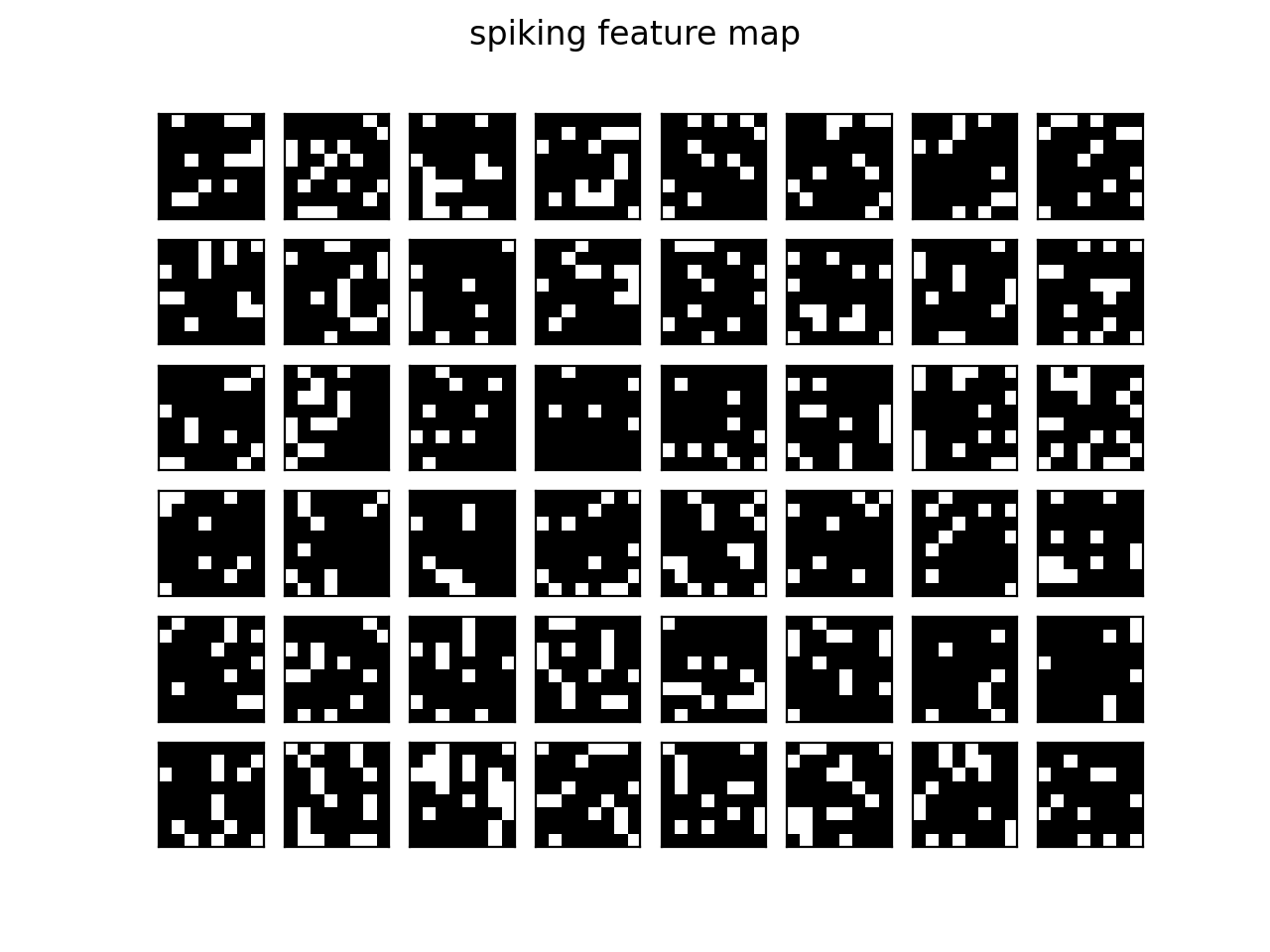SpikingFlow.visualizing package¶
Module contents¶
-
SpikingFlow.visualizing.plot_2d_heatmap(array: numpy.ndarray, title: str, xlabel: str, ylabel: str, int_x_ticks=True, int_y_ticks=True, plot_colorbar=True, colorbar_y_label='magnitude', dpi=200)[源代码]¶ - 参数
array – shape=[N, M]的任意数组
title – 热力图的标题
xlabel – 热力图的x轴的label
ylabel – 热力图的y轴的label
int_x_ticks – x轴上是否只显示整数刻度
int_y_ticks – y轴上是否只显示整数刻度
plot_colorbar – 是否画出显示颜色和数值对应关系的colorbar
colorbar_y_label – colorbar的y轴label
dpi – 绘图的dpi
- 返回
绘制好的figure
绘制一张二维的热力图。可以用来绘制一张表示多个神经元在不同时刻的电压的热力图,示例代码:
neuron_num = 32 T = 50 lif_node = neuron.LIFNode(monitor=True) w = torch.rand([neuron_num]) * 50 for t in range(T): lif_node(w * torch.rand(size=[neuron_num])) v_t_array = np.asarray(lif_node.monitor['v']).T # v_t_array[i][j]表示神经元i在j时刻的电压值 visualizing.plot_2d_heatmap(array=v_t_array, title='voltage of neurons', xlabel='simulating step', ylabel='neuron index', int_x_ticks=True, int_y_ticks=True, plot_colorbar=True, colorbar_y_label='voltage magnitude', dpi=200) plt.show()
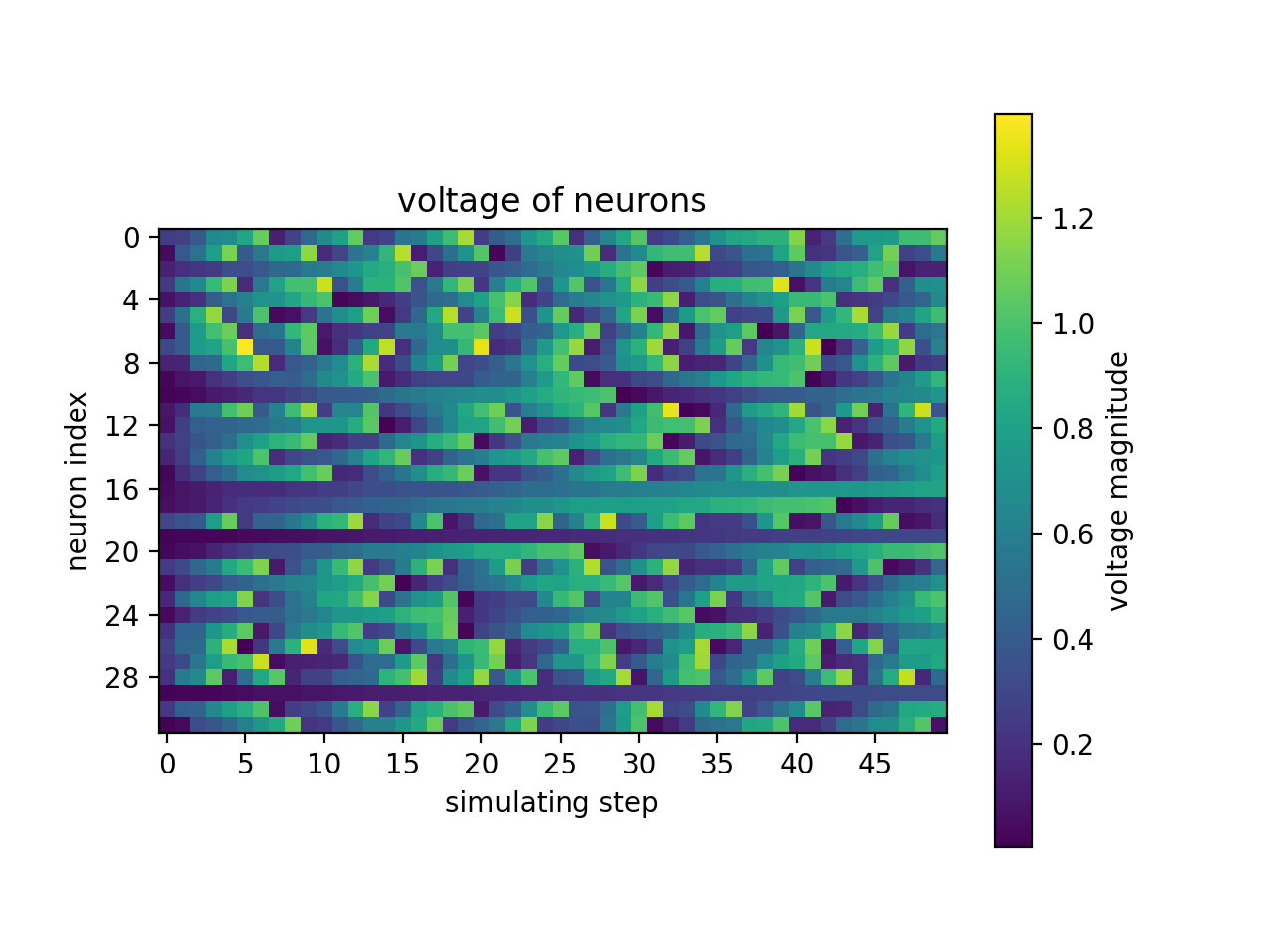
-
SpikingFlow.visualizing.plot_2d_bar_in_3d(array: numpy.ndarray, title: str, xlabel: str, ylabel: str, zlabel: str, int_x_ticks=True, int_y_ticks=True, int_z_ticks=False, dpi=200)[源代码]¶ - 参数
array – shape=[N, M]的任意数组
title – 图的标题
xlabel – x轴的label
ylabel – y轴的label
zlabel – z轴的label
int_x_ticks – x轴上是否只显示整数刻度
int_y_ticks – y轴上是否只显示整数刻度
int_z_ticks – z轴上是否只显示整数刻度
dpi – 绘图的dpi
- 返回
绘制好的figure
将shape=[N, M]的任意数组,绘制为三维的柱状图。可以用来绘制多个神经元的脉冲发放频率,随着时间的变化情况,示例代码:
Epochs = 5 N = 10 spiking_rate = torch.zeros(N, Epochs) init_spiking_rate = torch.rand(size=[N]) for i in range(Epochs): spiking_rate[:, i] = torch.softmax(init_spiking_rate * (i + 1) ** 2, dim=0) visualizing.plot_2d_bar_in_3d(spiking_rate.numpy(), title='spiking rates of output layer', xlabel='neuron index', ylabel='training epoch', zlabel='spiking rate', int_x_ticks=True, int_y_ticks=True, int_z_ticks=False, dpi=200) plt.show()
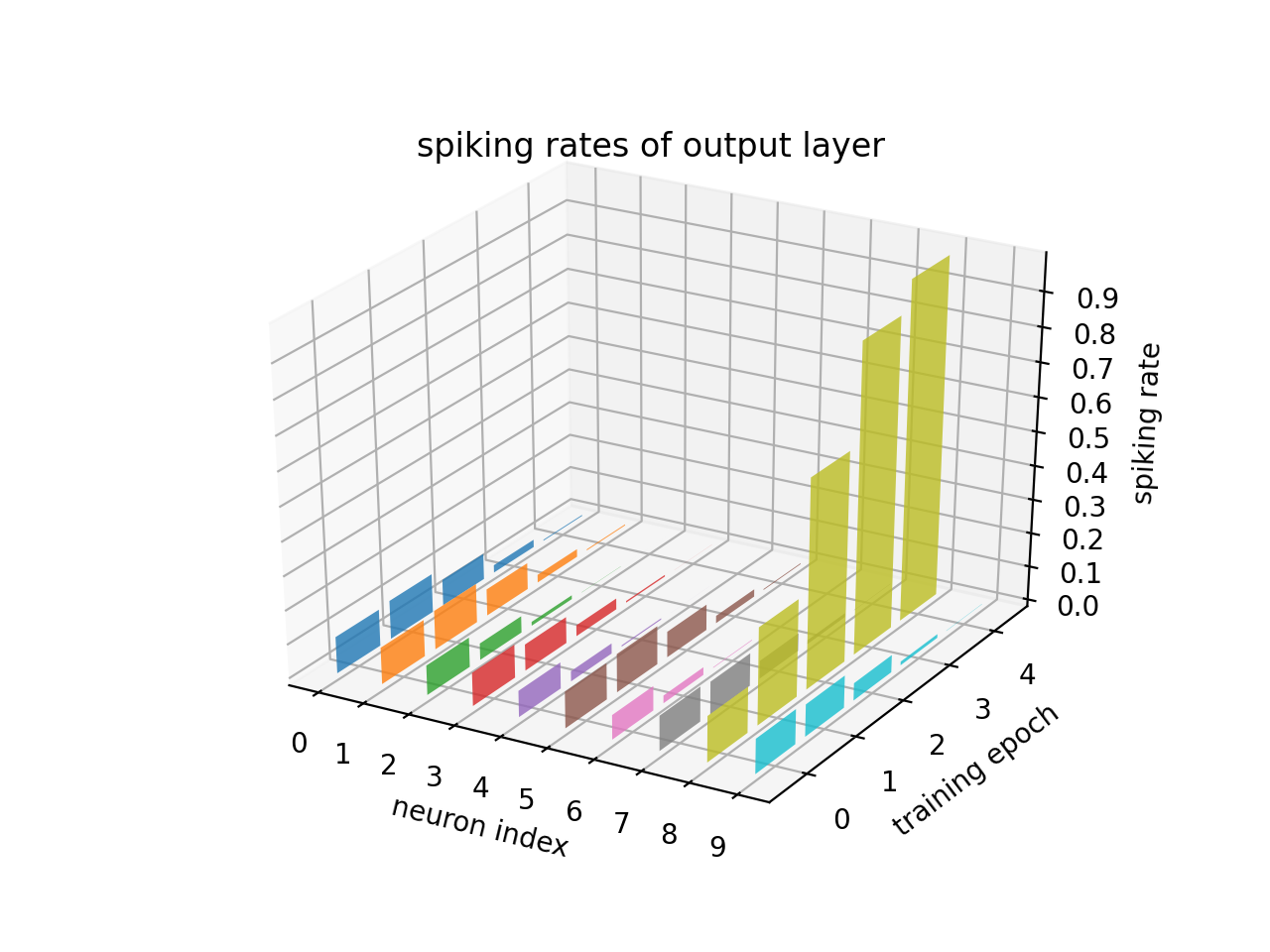
也可以用来绘制一张表示多个神经元在不同时刻的电压的热力图,示例代码:
neuron_num = 4 T = 50 lif_node = neuron.LIFNode(monitor=True) w = torch.rand([neuron_num]) * 10 for t in range(T): lif_node(w * torch.rand(size=[neuron_num])) v_t_array = np.asarray(lif_node.monitor['v']).T # v_t_array[i][j]表示神经元i在j时刻的电压值 visualizing.plot_2d_bar_in_3d(v_t_array, title='voltage of neurons', xlabel='neuron index', ylabel='simulating step', zlabel='voltage', int_x_ticks=True, int_y_ticks=True, int_z_ticks=False, dpi=200) plt.show()
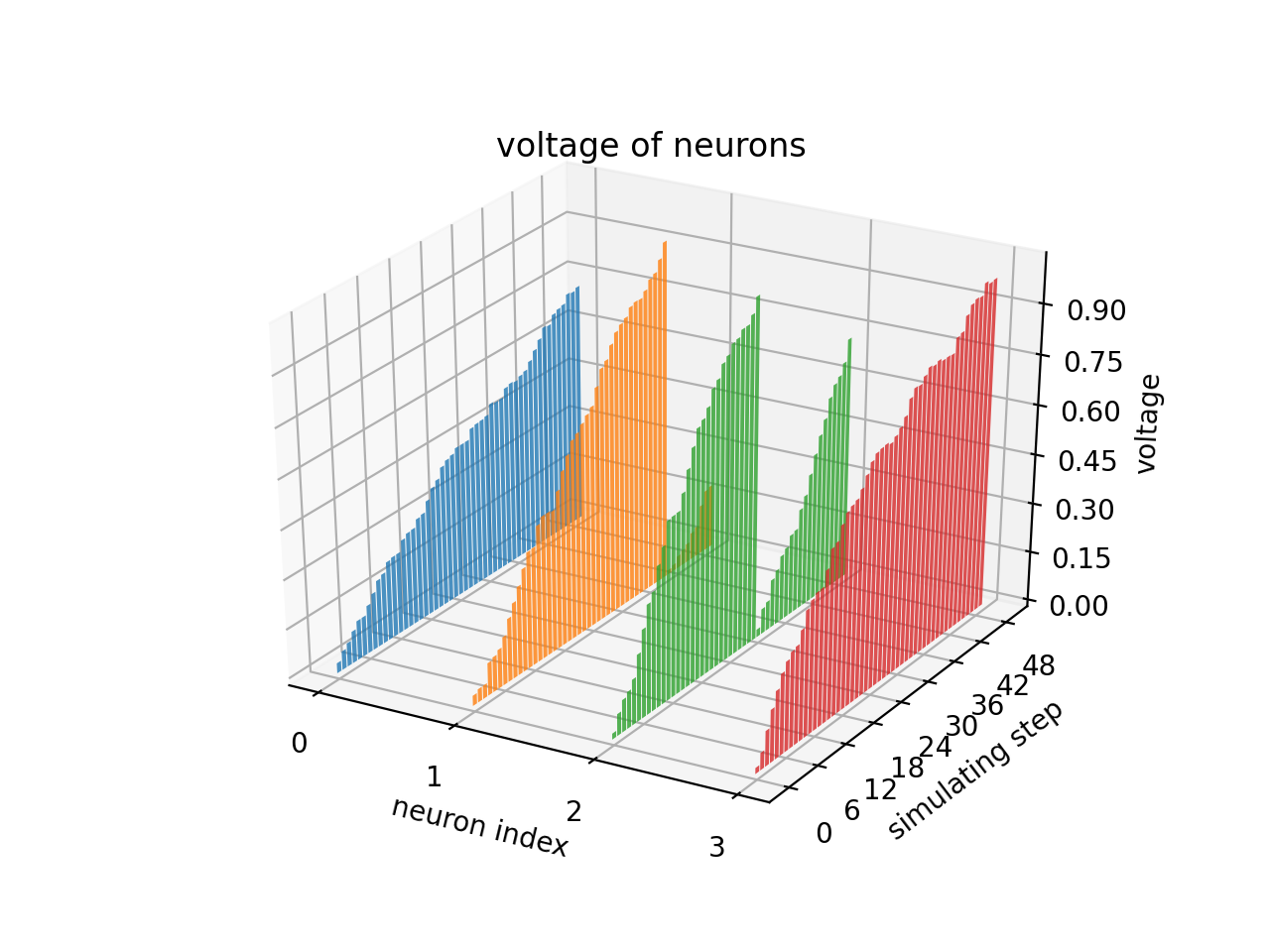
-
SpikingFlow.visualizing.plot_1d_spikes(spikes: numpy.asarray, title: str, xlabel: str, ylabel: str, int_x_ticks=True, int_y_ticks=True, plot_spiking_rate=True, spiking_rate_map_title='spiking rate', dpi=200)[源代码]¶ - 参数
spikes – shape=[N, T]的np数组,其中的元素只为0或1,表示N个时长为T的脉冲数据
title – 热力图的标题
xlabel – 热力图的x轴的label
ylabel – 热力图的y轴的label
int_x_ticks – x轴上是否只显示整数刻度
int_y_ticks – y轴上是否只显示整数刻度
plot_spiking_rate – 是否画出各个脉冲发放频率
spiking_rate_map_title – 脉冲频率发放图的标题
dpi – 绘图的dpi
- 返回
绘制好的figure
画出N个时长为T的脉冲数据。可以用来画N个神经元在T个时刻的脉冲发放情况,示例代码:
neuron_num = 32 T = 50 lif_node = neuron.LIFNode(monitor=True) w = torch.rand([neuron_num]) * 50 for t in range(T): lif_node(w * torch.rand(size=[neuron_num])) s_t_array = np.asarray(lif_node.monitor['s']).T # s_t_array[i][j]表示神经元i在j时刻释放的脉冲,为0或1 visualizing.plot_1d_spikes(spikes=s_t_array, title='spikes of neurons', xlabel='simulating step', ylabel='neuron index', int_x_ticks=True, int_y_ticks=True, plot_spiking_rate=True, spiking_rate_map_title='spiking rate', dpi=200) plt.show()
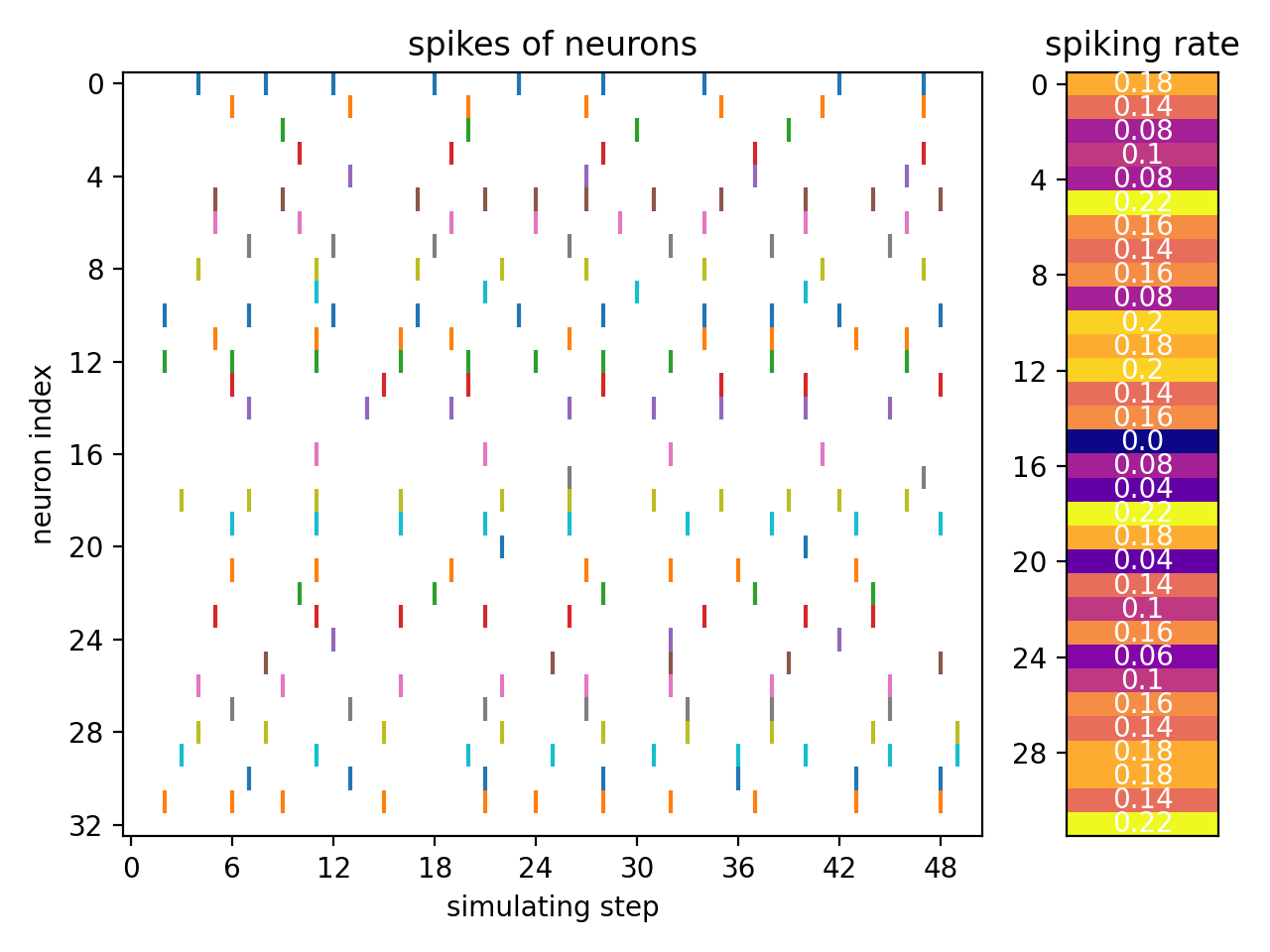
-
SpikingFlow.visualizing.plot_2d_spiking_feature_map(spikes: numpy.asarray, nrows, ncols, title: str, dpi=200)[源代码]¶ - 参数
spikes – shape=[C, W, H],C个尺寸为W * H的脉冲矩阵,矩阵中的元素为0或1。这样的矩阵一般来源于卷积层后的脉冲神经元的输出
nrows – 画成多少行
ncols – 画成多少列
title – 热力图的标题
dpi – 绘图的dpi
- 返回
一个figure,将C个矩阵全部画出,然后排列成nrows行ncols列
将C个尺寸为W * H的脉冲矩阵,全部画出,然后排列成nrows行ncols列。这样的矩阵一般来源于卷积层后的脉冲神经元的输出,通过这个函数可以对输出进行可视化。示例代码:
C = 48 W = 8 H = 8 spikes = (np.random.rand(C, W, H) > 0.8).astype(float) visualizing.plot_2d_spiking_feature_map(spikes=spikes, nrows=6, ncols=8, title='spiking feature map', dpi=200) plt.show()
